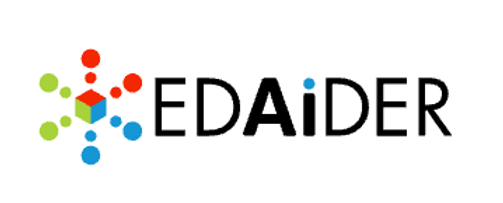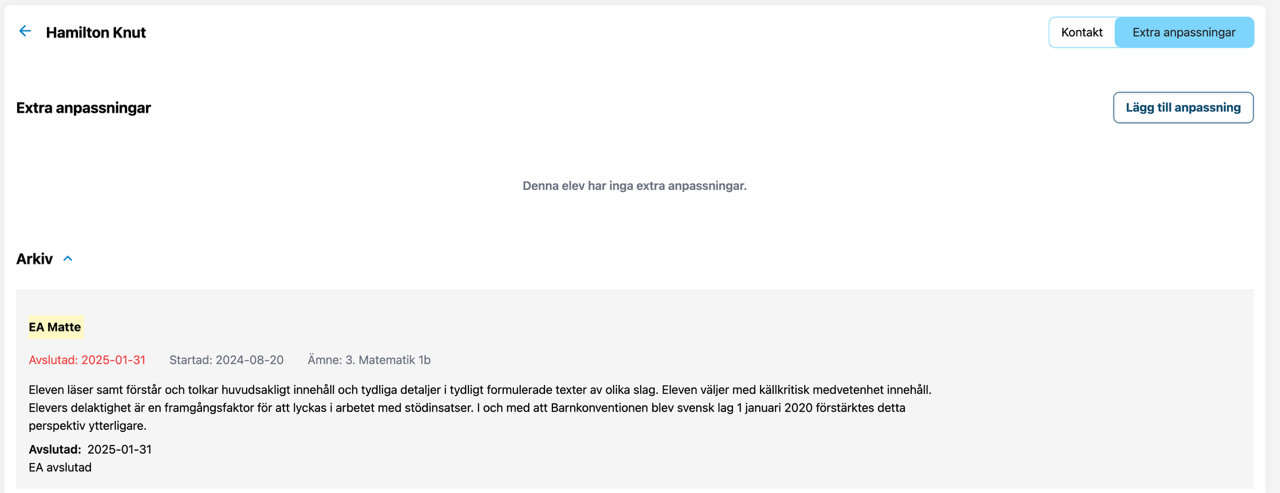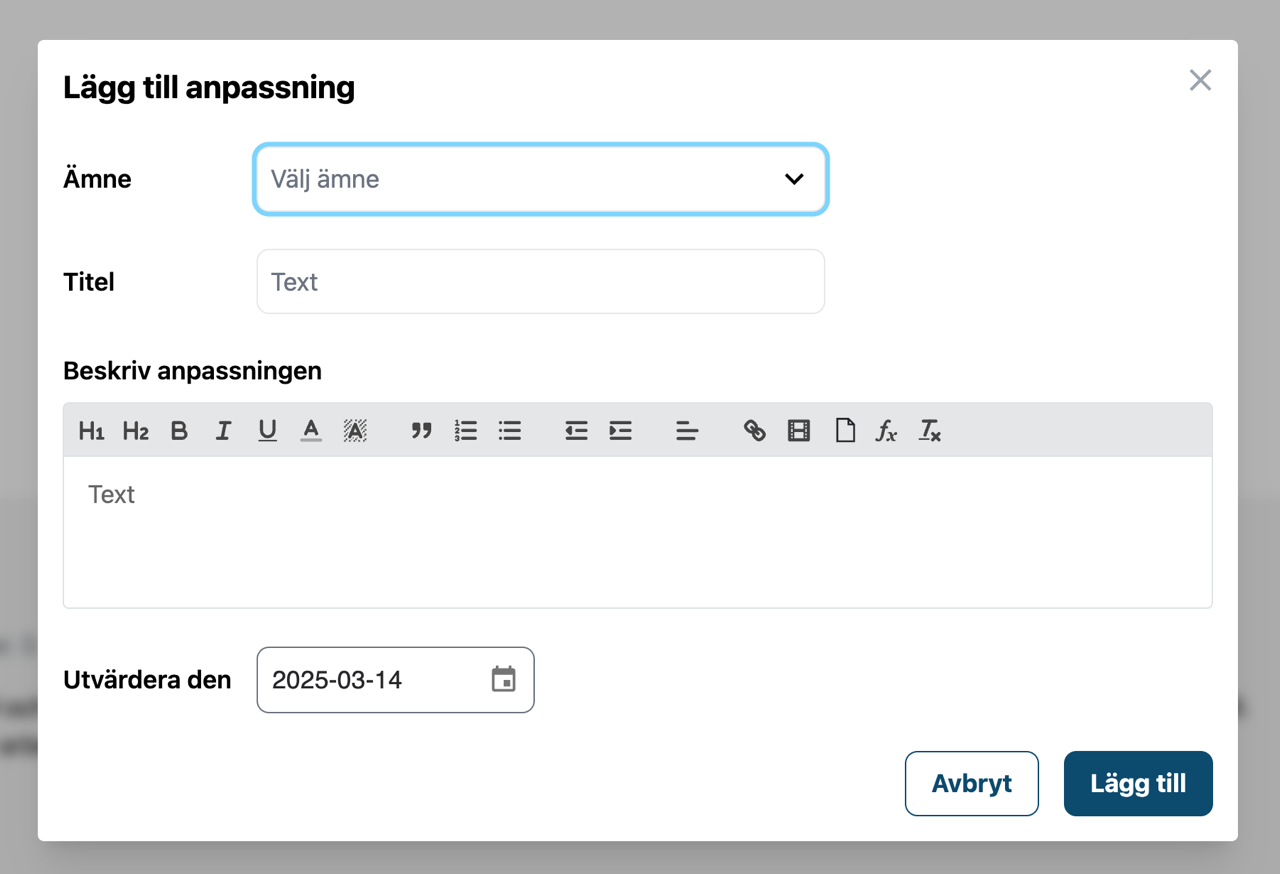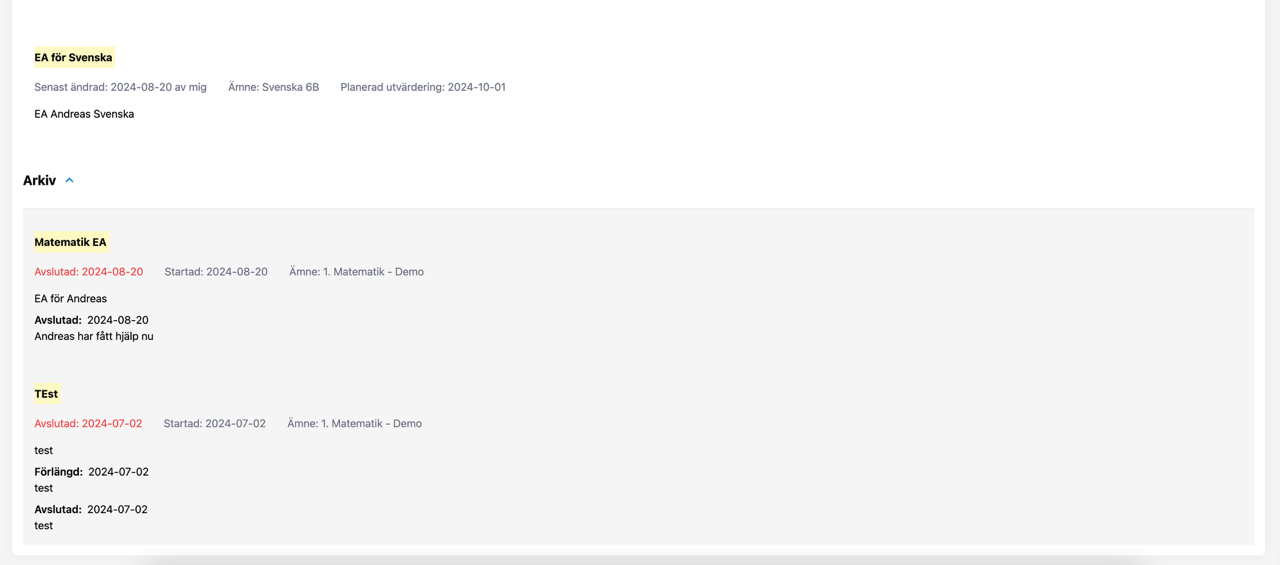UX Research
We researched the requirements from Skolverket and did a competitor analysis to figure out how others had solved the same problem.
Since we already knew that documentation of accommodations were a requirement in procurements, we decided to map out the process of how teachers worked with the accommodations and what importance the process had in the long term. We interviewed teachers, special pedagogs and principals.
Our insights from the research helped us understand what the actual problem was - the teachers needed an efficient way to document the accommodations, and they wanted to add the same accommodations to several students as they applied to more than one student - so that they could focus their time on helping the students meeting the curriculum goals.

EdAider The company

EdAider is a company that empowers schools with an innovative, research-driven school platform designed to optimize communication and documentation.
In addition, they provide schools with Sweden’s most widely used AI-course for teachers and students. Through their solutions, EdAider is committed to contribute to increased well-being, efficiency, and is aiming for a more inclusive and adaptive learning environment.
EdAider Case Research and UI:
Accommodations
Meet Lisa
Lisa is a teacher who really loves her job. She loves to see her students succeed, getting that “aha-moment” and lucky for her, that’s the main part of her job. She also creates accommodations for her students in need of it.


Lisa's student John
John is having a real hard time in math and he needs extra instructions to get started in every math lesson.
Lisa's student Alexa
Alexa is having a hard time in English class, reading the instructions and understanding what to do. Lisa needs to give her some extra instructions as well.

Lisa's documentation process
- When a student is at risk of not meeting the grading criteria, Lisa can provide her students with accommodations that she autonomously decide on.
- She executes the accommodations
- She documents them in the school platform for each student. She has several students in different classes in need of accommodations.
- Evaluation: After 6-8 weeks she has to evaluate the accommodations and decide how to move forward.
- The documentation serves as a basis to future actions in order to help the student meet the grading criteria.
Pain points
-
Lisa can’t see all of her students with accommodations at once. She has to go in to each class in the school platform and click on each student.
-
She can’t see other teacher’s accommodations for her students either.
-
Lisa can’t remember the evaluation date for each student, as she creates accommodations and documentation for them continuously during the school year.
-
Lisa has to create accommodations for each student individually.
-
With all the other tasks included in her work, the documentation is an important but very time consuming process that she wishes was more efficient.
Our solution
We decided to make the everyday life of Lisa and her colleagues a little bit easier.
-
We designed a UI that was intuitive and time efficient.
-
Lisa can now see all of her students and their accommodations, not only in her class, but in different courses.
-
We designed the documentation process so that Lisa had to set an evaluation date that will help remind her before saving the accommodations, so that she could keep track of her different student’s accommodations.
-
Due to time and budget restrictions, we decided to leave the feature of Lisa adding the same accommodations to different students at once, for next iteration.

Our solution - the student overview
Lisa gets an overview of all the students she teaches (even from different classes). She can also search for a specific student.

EdAider is a company that empowers schools with an innovative, research-driven school platform designed to optimize communication and documentation. In addition, they provide schools with Sweden’s most widely used AI-course for teachers and students. Through their solutions, EdAider is committed to contribute to increased well-being, efficiency, and is aiming for a more inclusive and adaptive learning environment.
Our solution - the student card
Lisa clicks on a student card and sees information of current and archived accommodations.

Our solution - adding accommodations

We designed a clean and simple UI for Lisa and her colleagues. Lisa can choose which subject to add accommodations to, describe the accommodations. and set the evaluation date.
Our solution - student accommodations overview

Lisa can view the current accommodations as well as archived ones. also see what accommodations in different courses that have worked for a student historically, by the copy “Extended” (Förlängd in Swedish).
The UX process
This project started as a requirement in the product, as the company were moving forward to access more of the market for school platforms. My deisgner colleague and I dove right into researching documents from Skolverket to get a better understanding what problem we were going to solve.
We quickly found that this was more about the process than creating a new feature in our product. If a student is at risk to not meet the grading criteria, the teachers are obliged to create accommodations as a part of their education environment. If these accommodations are not enough, the school have to start an action program with more comprehensive actions in order to help the student meet the grading criteria.
We did a competitor analysis to see the current solutions on the market today and then we interviewed several teachers and principals to better understand them and find out which problem we were going to solve.
With the insights from the interviews - that led us to the understanding of that it was a process we were going to design for, not a feature in our product - we did wireframes, tested them with users and then we iterated the wireframes. The wireframes turned into a hifi prototype that was later launched in the product.
The UX Process
This project started as a requirement in the product, as the company were moving forward to access more of the market for school platforms. My deisgner colleague and I dove right into researching documents from Skolverket to get a better understanding what problem we were going to solve.
We quickly found that this was more about the process than creating a new feature in our product. If a student is at risk to not meet the grading criteria, the teachers are obliged to create accommodations as a part of their education environment. If these accommodations are not enough, the school have to start an action program with more comprehensive actions in order to help the student meet the grading criteria.
We did a competitor analysis to see the current solutions on the market today and then we interviewed several teachers and principals to better understand them and find out which problem we were going to solve.
With the insights from the interviews - that led us to the understanding of that it was a process we were going to design for, not a feature in our product - we did wireframes, tested them with users and then we iterated the wireframes. The wireframes turned into a hifi prototype that was later launched in the product.

Project: Accommodations documentation
The problem
If a student struggles to meet the curriculum goals, the teacher can provide the student with accommodations - it could be in forms of tweaking the teaching approach, providing extra resources, or changing how the material is presented.
The accommodations are documented and serves as a foundation for decisions on further support to help the student meet the curriculum goals. The leading school platforms on the market do not support that documentation process in an efficient way.
EdAider
Summary:
EdAider needed to design a user-centered solution for documenting student accommodations in order to meet procurement requirements and strengthen their offering. Existing platforms lacked efficient, user-friendly tools, and teachers struggled with time-consuming, fragmented processes.
Key takeaways
To meet both user needs and procurement demands, EdAider developed a smart, user-centered documentation tool that showed clear class overviews, and built-in evaluation reminders - filling a critical gap in the market.



Key Insights
- Accommodations made autonomously by teachers
The process was not too complex; the teacher decided autonomously on different accommodations depending on what the student’s need of support was and executed that. The accommodations were evaluated after approximately 6-8 weeks and could be iterated, adjusted and/or exchanged by the teacher if they were not successful.
- Documentation for further actions
All accommodations needed to be documented, as they would serve as a foundation for decisions on further actions to help the student meet the curriulum goals.
- Bulk accommodations
The informants showed a clear need for a smooth process of documentation - several requested a feature where a teacher could bulk the accommodations to several students in need of the same kind of support.
- Easy accessible overview
Another essential need was to be able to easily see all the accommodations all of the students in a class had.
- Evaluation date tracker
The teachers had trouble keeping track of when the accommodations were due to evaluation (after 6-8 weeks), because the accommodations were not executed simultanously with each student and accommodations are quite usual in the school.
- User-centered and time efficient
The solutions on the market today are still not time efficient and not tailored to the actual needs of the teachers.
Challenge
How to create a smarter solution than the existing on the market - that actually improves the UX for the teachers and give them more time to focus on the students and their learning. The answer to that question was to talk to the users and get an understanding of how they perceived the current products on the market. From our key insights we created a user flow, that we used to create wireframes.



Solution
Due to a tight schedule, we chose to design a solution that met the most important user needs that also would benefit the business goals, which was to get this feature out to the users as soon as possible, to be able to compete with other competitors in procurements.
We designed for these user needs:
- The teachers could add accommodations to several students at the same time
- We built an overview of the accommodations of all students and they could be sorted in a class or group
- The teachers had to set an evaluation time before adding the accommodation, so that the system could remind them of the evaluation.
Testing
When we had designed the first wireframes, we tested early with several users and the feedback we got was that it looked clean and simple and met the core needs of the teachers.

Lessons learned
- The value of talking to users
- Through interviews we found the real issues
- Usability testing gave insights to improve the prototype
Conclusion: We designed a data-driven solution that improved the teachers workflow and enabled them to spend more time with their students in order to help them meet the grading criteria.